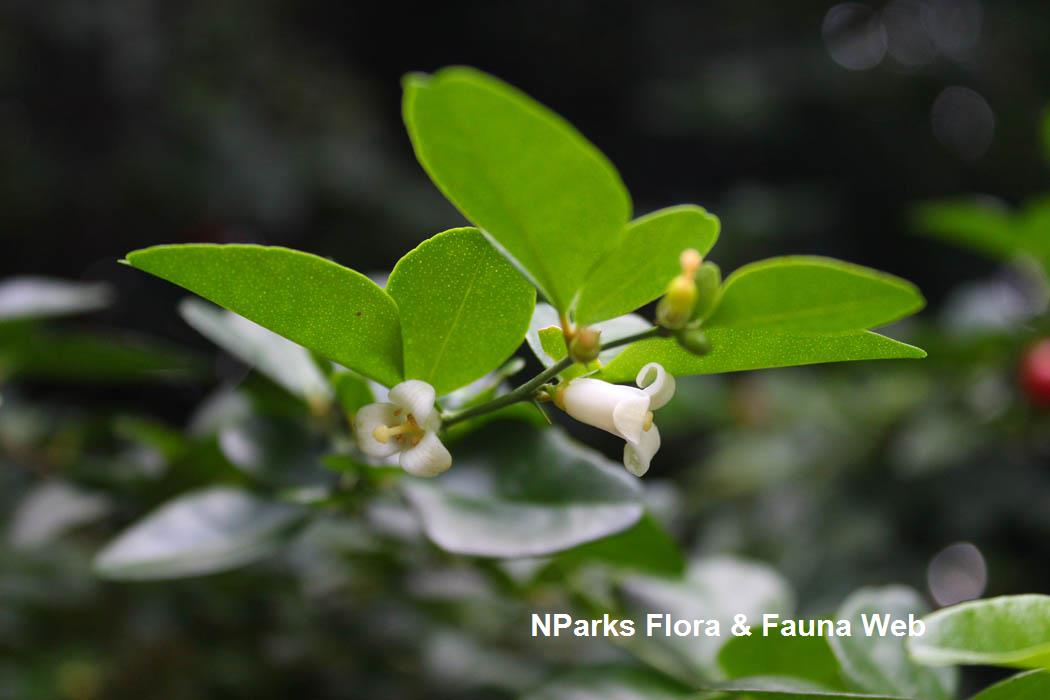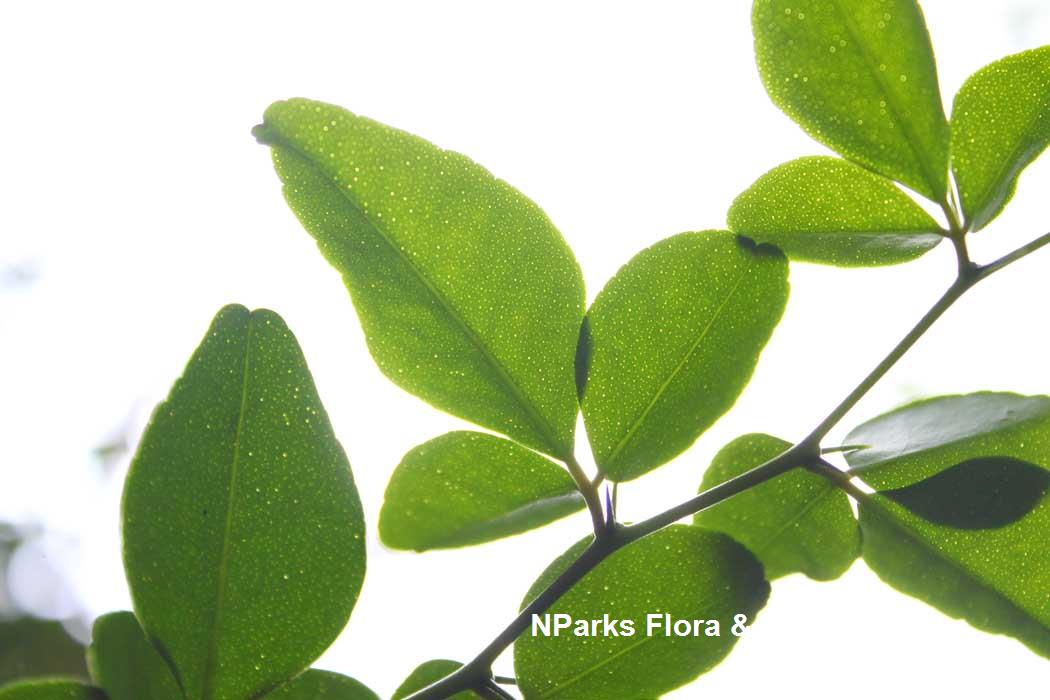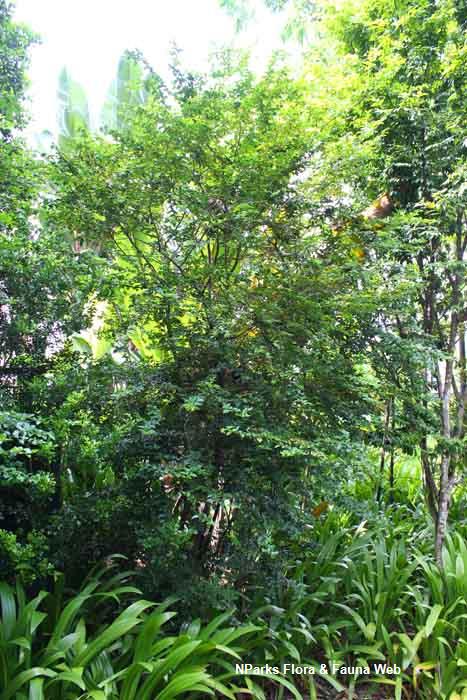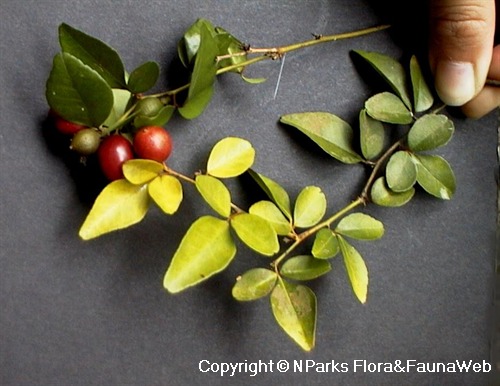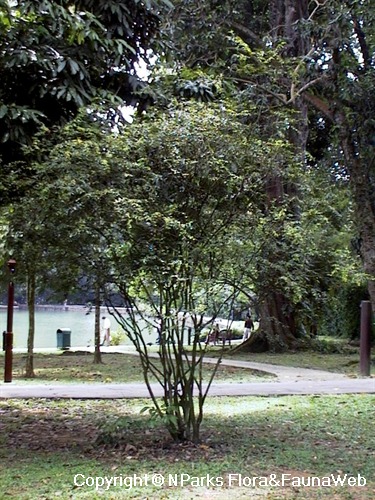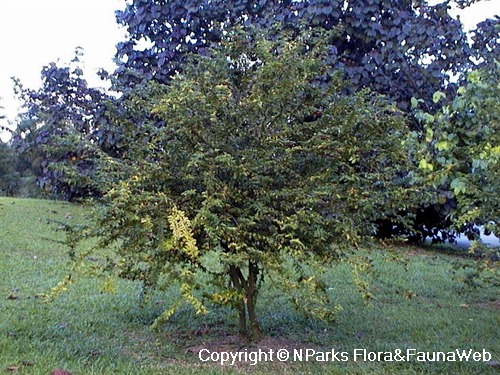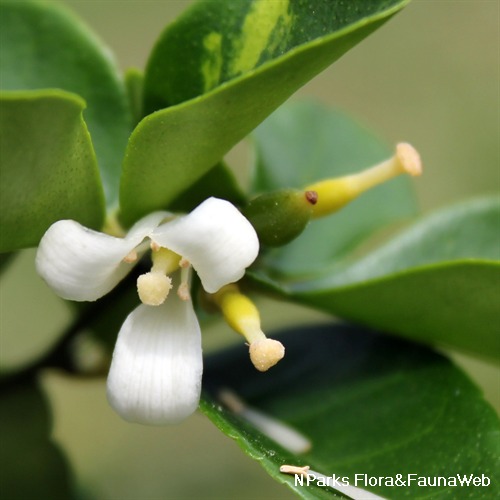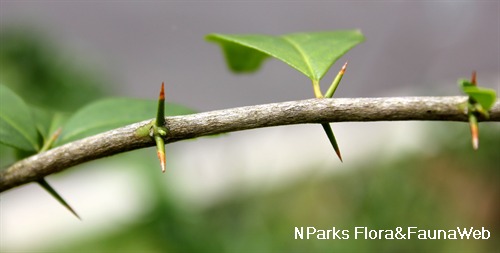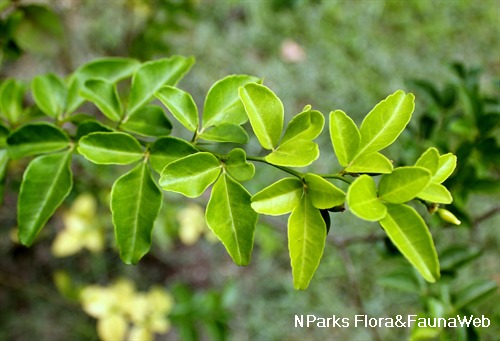
Back
Triphasia trifolia (Burm.f.) P.Wilson
| Family Name: | Rutaceae |
| Synonyms: | Limonia trifolia, Limonia diacantha, Limonia retusa, Limonia trifoliata, Triphasia aurantiola, Triphasia diacantha, Triphasia javanica, Triphasia trifoliata |
| Common Name: | Limeberry, Limau Keah, Limau Kiah, Limau Kikir, Kelingket |
Limeberry (Triphasia trifolia) is an erect shrub that grows to approximately 1.6 m when cultivated as a hedge. It features distinctive three-leaflet leaves and produces fragrant white flowers. This plant thrives in both full sun and semi-shade conditions with moderate watering requirements. Its edible fruit has has an astringent taste and ripen from bright red to dark red as they mature.
Name
Classifications and Characteristics
| Plant Division | Angiosperms (Flowering Seed Plants) (Dicotyledon) |
|---|---|
| Plant Growth Form | Tree (Shrubby (1m-5m)), Shrub |
| Lifespan (in Singapore) | Perennial |
| Mode of Nutrition | Autotrophic |
| Maximum Height | 1.6 m |
Biogeography
| Native Distribution | Bangladesh, Andaman Islands, Nicobar Islands, Myanmar, Cambodia, Vietnam, Peninsular Malaysia, Borneo, Java, Lesser Sunda Islands, Cocos (Keeling) Islands, Maluku, Philippines, Christmas Islands, New Guinea, Solomon Islands. |
|---|---|
| Native Habitat | Terrestrial |
| Preferred Climate Zone | Tropical, Sub-Tropical / Monsoonal |
| Local Conservation Status | Non-native (Horticultural / Cultivated Only) |
Description and Ethnobotany
| Growth Form | An erect, spiny shrub growing to 1.6 m tall in Singapore, but sometimes forms a small tree. |
|---|---|
| Foliage | Compound leaves are composed of 3 elliptic leaflets with the terminal leaflet twice as large as the lateral leaflets (terminal leaflet: 2-4 cm long, lateral leaflets: 1.2-2 cm long, 0.8-1.2 cm wide); leaf tip is retuse or rounded, and base is cuneate. A pair of spines is located at the leaf axils, measuring 0.4 - 1.2 cm long. The leaves has dotted glands. |
| Flowers | Fragrant, white flowers are composed of 3 oblanceolate petals which are reflexed at the tip. They are produced throughout the year in small clusters of 2-3 in the leaf axils (area between the upper surface of the leaf and adjacent stem). |
| Fruit | Bright red ripening to dark red, fleshy fruits are round to ellipsoid (1-1.5 cm long). The fruit surface has gland dots, these are oil glands that smell like lemon. Each fruit contains 1-3 seeds embedded within a mucilaginous pulp. Fruits are produced continuously throughout the year. |
| Habitat | This species is found growing in the wild, and is able to grow in the understorey layer of secondary forests, growing in thickets at low altitudes, and often cultivated as hedges. This species has colonized forests in introduced areas and spread through bird droppings. |
| Cultivation | This species grows best in open sunny and semi-shade areas. It grows in well-drained soil, disturbed sites or areas with human habitation, and best in sandy loam soil (pH 5-6). It cannot tolerate waterlogged soils. In Malaya, this species is a cultivated species where it is grown as a hedge in Malay villages <2>. |
| Etymology | The genus epithet Triphasia means triple, which likely refers to the 3 petals. The specific epithet trifolia means having 3 leaflets. |
| Ethnobotanical Uses | Edible Plant Parts : Edible Fruits Medicinal: Traditional Medicinal Uses In Philippines, the fruit of the plant are used by Talaandig tribe to treat coughs and sore throats. <3> <4> <5> In Indonesia, the leaves are used to treat colic, diarrhea and skin diseases, and in cosmetics in Indonesia. <1> |
Landscaping Features
| Landscaping | The plant produces attractive and fragrant, white, 3-petalled flowers and bright red fruit with lemon-like scent. Plant is suitable for growing as hedges. |
|---|---|
| Desirable Plant Features | Fragrant (Flowers), Ornamental Flowers, Ornamental Fruits |
| Landscape Uses | General, Parks & Gardens, Hedge / Screening, Container Planting |
| Usage Hazard - Cons | Spines/Thorns - Stem/Branch |
Fauna, Pollination and Dispersal
| Seed or Spore Dispersal | Biotic (Fauna) |
|---|
Plant Care and Propagation
| Light Preference | Full Sun, Semi-Shade |
|---|---|
| Water Preference | Moderate Water |
| Plant Growth Rate | Moderate |
| Rootzone Tolerance | Fertile Loamy Soils, Well-Drained Soils |
| Propagation Method | Seed, Stem Cutting |
Foliar
| Foliage Retention | Evergreen |
|---|---|
| Mature Foliage Colour(s) | Green |
| Mature Foliage Texture(s) | Smooth |
| Prominent Young Flush Colour(s) | Green |
| Young Flush Texture(s) | Smooth |
| Foliar Type | Compound (Trifoliate) |
| Foliar Arrangement Along Stem | Alternate |
| Foliar Attachment to Stem | Petiolate |
| Foliar Shape(s) | Non-Palm Foliage (Elliptical, Ovate) |
| Foliar Venation | Pinnate / Net |
| Foliar Margin | Entire |
| Foliar Apex - Tip | Retuse, Rounded |
| Foliar Base | Cuneate |
| Leaf Area Index (LAI) for Green Plot Ratio | 3.0 (Tree - Intermediate Canopy) |
Floral (Angiosperm)
| Flower & Plant Sexuality | Bisexual Flowers |
| Flower Colour(s) | White |
|---|---|
| Flower Grouping | Solitary |
| Flower Location | Axillary |
| Flower Symmetry | Radial |
| Flowering Period | Free-Flowering |
| Flowering Habit | Polycarpic |
Fruit, Seed and Spore
| Mature Fruit Colour(s) | Red |
|---|---|
| Mature Fruit Texture(s) | Smooth, Glossy / Shiny |
References
| References | <1> Abdullah, S., Mat Taha, R., Hasbullah, N.A. & Mohamed, N. (2008). Tissue culture, anatomical and morphological studies of Triphasia trifolia (Burm.f.) P.Wilson. Acta Horticulturae. 110-118. <2> Chen, L.M.J., Chua, K.S., Jong, Y.W., Choo, L.M. & Ho, B.C. (2025). Additions to the Flora of Singapore: New and overlooked records of casual and naturalised plant species (7). Gardens' Bulletin Singapore 77(1):17-32. <3> Jansen, P.C.M., Jukema, J., Oyen, L.P.A. & van Lingen, T.G. (1991). Triphasia trifolia (Burm.f.) P. Wilson. Verheij, E.W.M. and Coronel, R.E. (Editors): Plant Resources of South-East Asia No. 2: Edible fruits and nuts. PROSEA Foundation, Bogor, Indonesia. Accessed on 25 Aug 2025 from prota4u.org/prosea <4> Naive, M.A.K., Binag, S.D.A. & Alejandro, G.J.D. (2021). Plants with benefits: Ethnomedicinal plants used by the Talaandig tribe in Portulin, Pangantucan, Bukidnon, Philippines. Indian Journal of Traditional Knowledge. Vol 20(3):754-766. Accessed on 25 Aug 2025 from http://op.niscpr.res.in/index.php/IJTK/article/download/26584/465479539 <5> Nurfitriyana, N., Yanuarti, R., & Ekadipta, E. (2022). Edukasi Pemanfaatan Tanaman Obat Keluarga: Jeruk Kingkit (Triphasia trifolia) sebagai Alternatif Obat Batuk. Accessed on 25 Aug 2025 from https://journals.uima.ac.id/index.php/JLS1/article/view/2078 |
|---|
Image Repository
Others
| Master ID | 1901 |
|---|---|
| Species ID | 3194 |
| Flora Disclaimer | The information in this website has been compiled from reliable sources, such as reference works on medicinal plants. It is not a substitute for medical advice or treatment and NParks does not purport to provide any medical advice. Readers should always consult his/her physician before using or consuming a plant for medicinal purposes. |

